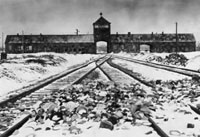 |
|
An undated archive photo shows Auschwitz II-Birkenau's main
guard house which prisoners called 'the gate of death' and the
railway with the remains of abandoned crockery. The railway,
which was built in 1944, was the last stop for the trains
bringing Jews to the death camp.
(Reuters) | |
Jerzy Afanasjew's body tenses and his eyes close when he recalls the
day he crawled out from the overcrowded cattle train as a 14-year-old boy
to begin a six-month nightmare.
"What was Auschwitz? It was hell. Hell. A death factory," he says in a
measured pace. "If you weren't gassed, you were exhausted to death, if you
weren't exhausted to death, you starved, if you didn't starve, you died of
disease."
Afanasjew is one of a dwindling group of people who, by
chance or cunning, cheated death at Auschwitz, the biggest Nazi
extermination camp during World War II that has become the symbol of the
Holocaust.
On Jan. 27, hundreds of survivors and dozens of world leaders will
commemorate the 60th anniversary of the camp's liberation by the Soviet
army and pay homage to the estimated 1.5 million people, mostly Jews,
murdered there by the Nazis.
"Auschwitz is a place where we share the responsibility to remember the
past with the goal of building a better society," said Abver Shalev,
chairman of Israel's Yad Vashem Holocaust remembrance institute, who will
attend the commemorations.
Set up in 1940 by occupying Nazi forces near the town of Oswiecim in
southern Poland as a labor camp for Poles, Auschwitz gradually became the
centerpiece in Nazi dictator Adolf Hitler's "final solution" plan to
exterminate Jews.
The scale of the industrialized killing at the camp, the cruelty of the
guards and the pseudo-medical
experiments conducted on prisoners by Nazi doctors have made Auschwitz
synonymous with a coldly efficient genocide and total degradation of
humanity.
Men, women and children -- mostly Jewish, but Gypsies, Russians and
Poles too -- from Nazi-occupied Europe were taken to Auschwitz in
overcrowded cattle trains. Many died of hunger and suffocation during the journey which usually
lasted days.
Terrified, foul-smelling and starving, those who made the trip were
often relieved at the prospect of fresh air and food. They did not know
that the smoke from nearby chimneys was coming from crematoria burning the bodies of
earlier arrivals.
Illusions were quickly dispelled as the guards separated those capable
of hard work from the elderly and children who were sent straight to the
gas chambers -- the process known in the
camp as "selection."
Those who survived the "selection," not knowing what happened to family
and friends, were stripped of their clothes, belongings and identity. A
number was tatted on their arm and they were given a soup bowl and spoon.
Dressed in characteristic striped uniforms, the prisoners were then
marched toward the labor camp under the gate adorned with giant
inscription "Arbeit Macht Frei" (work sets one free) that came to
symbolize the depth of Nazi cynicism.
Crammed in bare wooden or brick barracks, prisoners worked 12-hour days
in construction and factories. Better jobs were found in the kitchens or
offices.
After sleepless nights and long hours of backbreaking work, the prisoners
were forced outside to attend roll-calls which lasted for hours. Those who
died were piled up next to the standing to be counted.
Compounded by epidemics, the death rate of prisoners was 19-25 percent
a month in 1942-43.
(Agencies) |
当他回想起14岁那年的一天,自己从拥挤不堪的装运牲口的火车中爬出来开始6个月噩梦(般的生活)时,杰尔茨·阿法纳斯奇全身紧绷,双眼紧闭。
“奥斯维辛是什么?它是地狱。地狱。一个死亡工厂。”他有节奏地说道,“如果你没有被毒气毒死,你会累死,如果你没有累死,你会饿死,如果你没有饿死,那么你会病死。”
阿法纳斯奇是极少数靠运气或机智从奥斯维辛活着出来的人之一,奥斯维辛是二战中最大的纳粹灭绝营,现在已成为大屠杀的象征。
1月27日,几百名幸存者和世界(各国)的许多元首们将共同纪念前苏联军队解放奥斯维辛集中营60周年,并向被纳粹屠杀的约150万人——其中多数为犹太人——致敬。
以色列Yad
Vashem大屠杀纪念馆馆长阿布沃尔·沙利说:“要建设一个更美好的社会,我们有责任牢记过去,牢记奥斯维辛。”他将出席这次的纪念活动。
1940年,占领波兰南部城镇奥斯维辛附近的纳粹军队建造了一座波兰劳工营,后来奥斯维辛逐渐成为纳粹独裁者阿道夫·希特勒消灭犹太人的“最后解决”计划的中心。
奥斯维辛集中营中工业化屠杀的规模,残暴的警卫以及纳粹医生在囚犯身上进行的所谓“医学实验”都让人们一提到奥斯维辛,就想到无情的大屠杀和人性的彻底泯灭。
纳粹军队用牛车把男人、女人和儿童从占领的欧洲地区押送到奥斯维辛,牛车上拥挤不堪,其中大部分是犹太人,但也有吉普赛人,俄国人和波兰人。在长达几天的旅途中,许多人因饥饿、窒息而死。
那些惊恐万分,浑身散发着臭味而且极度饥饿的幸存者们常常被安慰说等待他们的是新鲜的空气和食物。他们并不知道附近烟囱里的滚滚浓烟却是那些先来的人的尸体被火化时冒出的浓烟。
幻想很快就破灭了,警卫们挑选出能够进行重体力劳动的人,而老人孩子们则被直接送进毒气室。在集中营中这一过程被称为“分选”。
“分选”出来的幸存者们一点都不知道他们的家人和朋友的遭遇。他们的衣服、财物和身份证明统统被没收,纳粹在他们的手臂上纹上号码,并发给每人一个汤碗和一把汤勺。
囚犯们穿着特制的条纹狱服,列队前往劳工营。劳工营的大门上醒目地写着“劳动获得自由”的巨大标语——纳粹犬儒主义的集中体现。
木头或砖瓦搭建的简易房舍里塞满了囚犯,他们每天在建筑(工地)或工厂工作12小时。好一些的在厨房或办公室工作。
在无数不眠之夜和长时间高强度工作之后,囚犯们还被迫进行几小时的露天点名。死囚的尸体就堆放在活人旁边以待清点。
加上流行疫病,1942至1943年期间每月囚犯的死亡率达到19%至25%。
(中国日报网站译) |
